Writing prompts and tips for all of those who itch when they're not putting pen to paper or fingers to keyboards, but need a little nudge to start. Use them freely for whatever they inspire you to do. You can also follow me on Instagram @writeroftheprompts and check out my personal blog @me-behind-the-words.
Don't wanna be here? Send us removal request.
Text
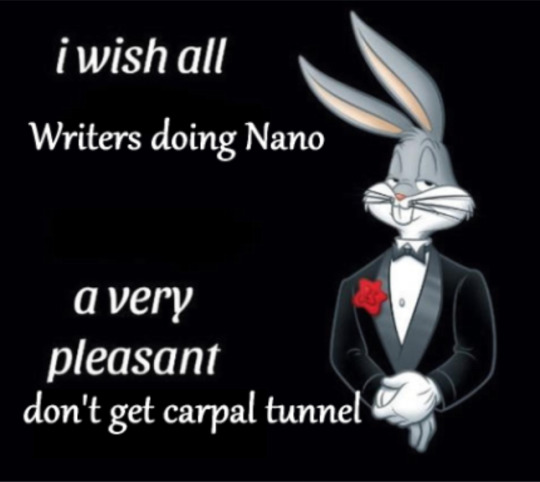
Take frequent breaks (drink water too!) and do your goddamn wrist stretches
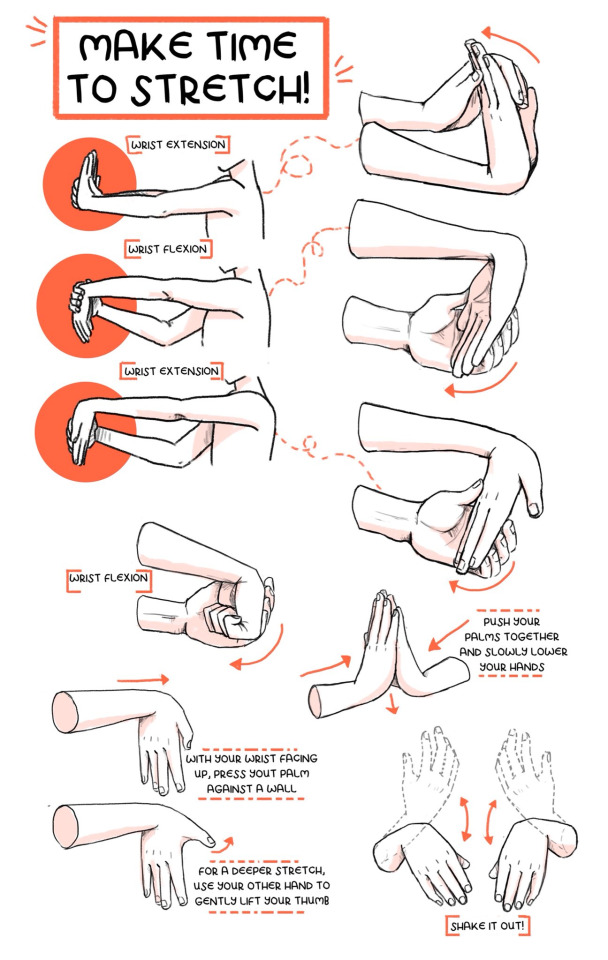
Image (source)
71K notes
·
View notes
Text
Magic Prompts ✨
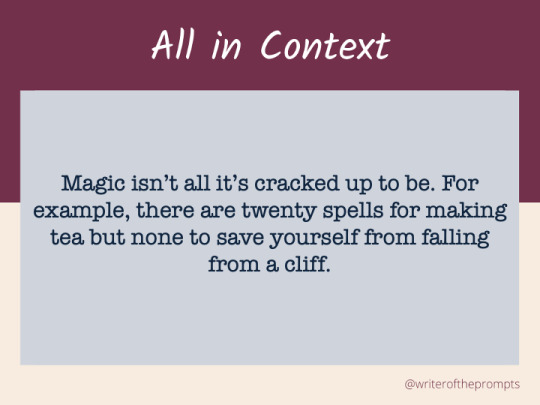
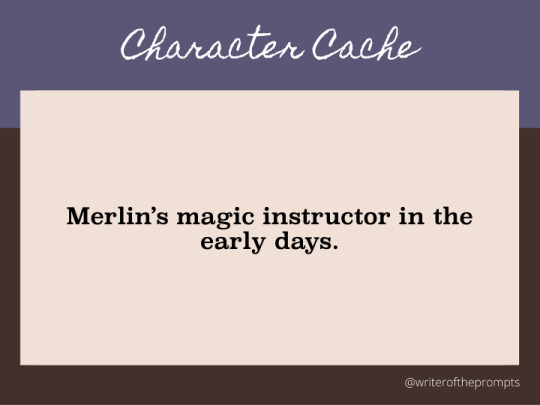
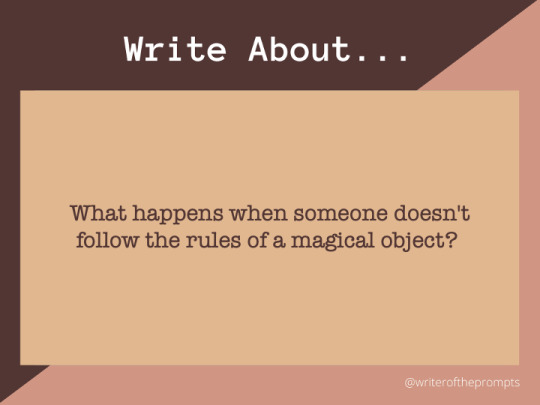
#writing prompt#writing inspiration#writeblr#plot prompt#character inspiration#fantasy#magic#wizards#witches
92 notes
·
View notes
Text
Romance Writing Prompts ❤️
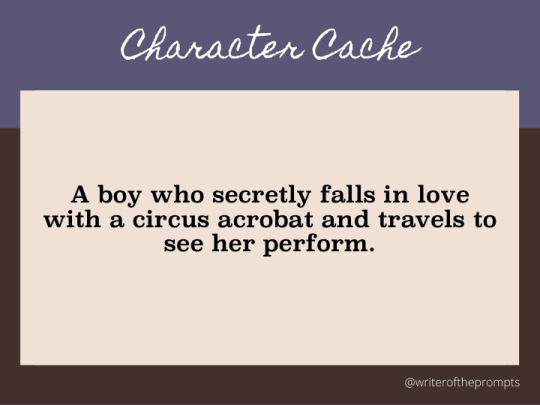
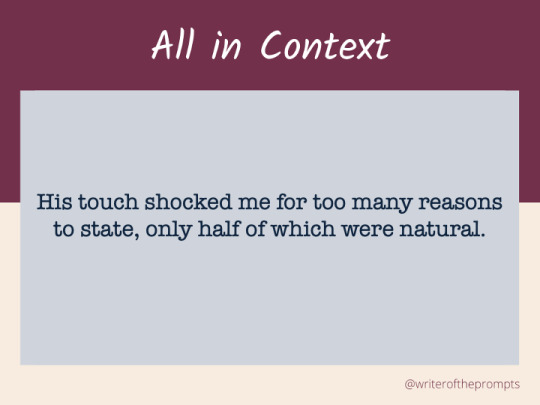

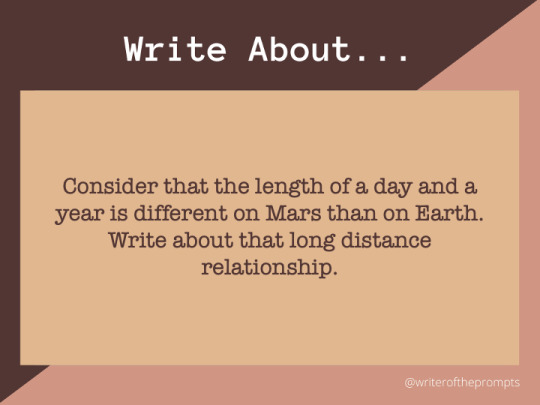
#writing prompt#writing inspiration#writeblr#plot prompt#character inspiration#romance prompts#romance
88 notes
·
View notes
Text
Paranormal Writing Prompts 👻


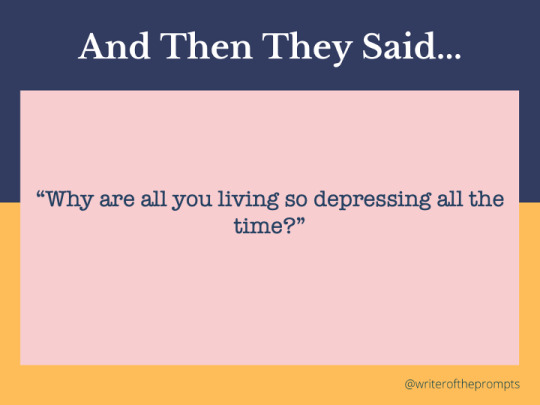

#writing prompt#writing inspiration#writeblr#plot prompt#character inspiration#paranormal#paranormal prompts#ghosts
118 notes
·
View notes
Text
Thriller Writing Prompts!

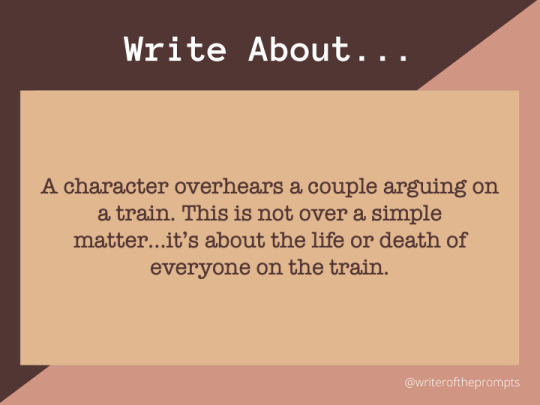

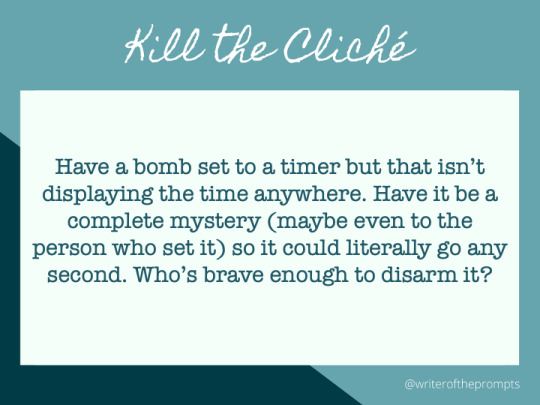
59 notes
·
View notes
Note
Why do you reblog your own fics so much?
Because someone might as well!? And look at this. Look. At. This.



Does this look right to you??
These are just the last three fics I wrote. I appreciate the likes, believe me I do, but you have to understand. Likes do nothing for content creators. It’s the reblogs. Because that’s how you find shit on your dashboard. Through reblogs. Not likes. This isn’t twitter or tiktok or instagram. This is a website that’s run by the reblog system.
Reblogging helps content creators put their stuff out there. Why do you think so many people stopped writing fanfic and creating beautiful fanart and edits? It’s because they put in hours of work and don’t get nearly enough notes for their masterpieces. Yes we do this because we enjoy it but like…some validation won’t hurt. A boost of confidence here and there might be all someone needs to finish whatever thing they started and left.
Anyway, I’m still going to reblog my shit…
98K notes
·
View notes
Text
Sci-Fi Writing Prompts!
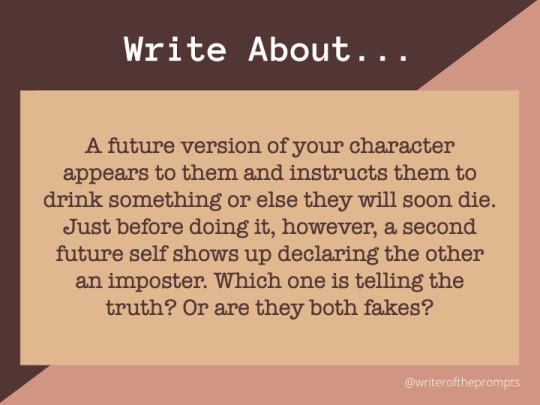
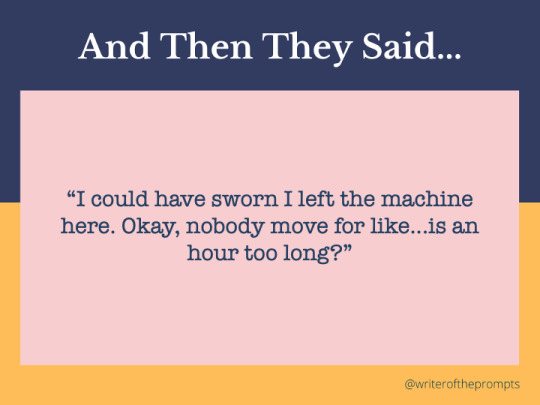
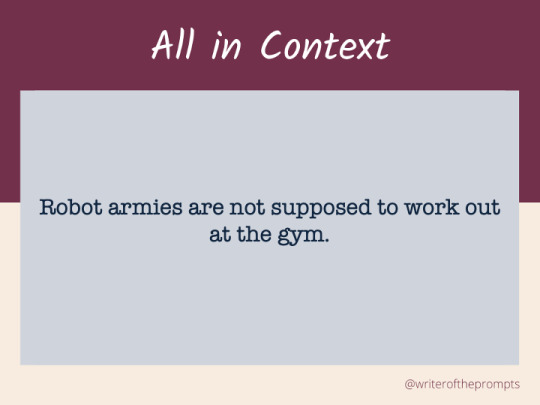
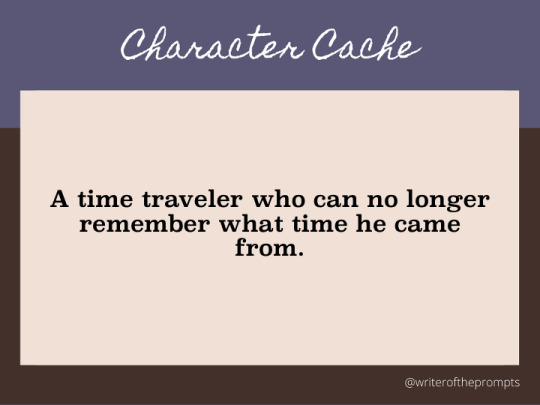
#writing prompts#writeblr#writing inspriation#sci fi#sci fi prompts#plot prompt#character inspiration#time travel
110 notes
·
View notes
Photo
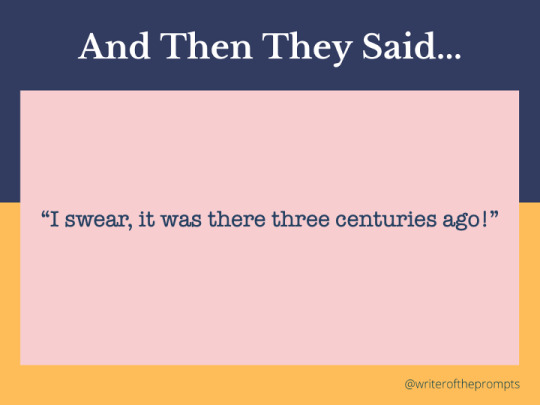

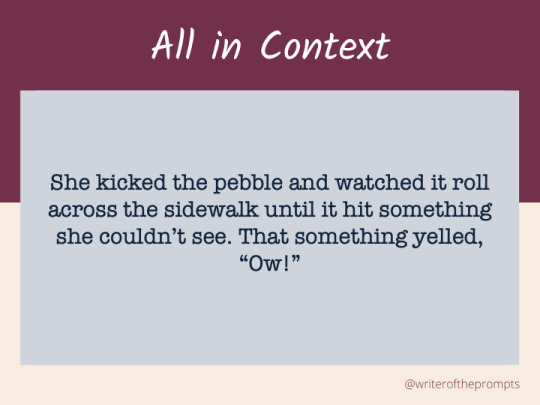

Fantasy writing prompts!
I’ve decided to start compiling some genre specific prompts for those looking for inspiration. You can also search for genres and tropes on the blog.
(Text description in image captions)
#writing prompts#writeblr#writing inspiration#fantasy#fantasy prompts#plot prompts#character inspiration
176 notes
·
View notes
Text
I took some historical sword-fighting lessons to make the fights in my novel more realistic - here’s what I learned.

To make the fighting scenes in my low fantasy novel more realistic, I went to see a trainer for historical sword-fighting last week, both to barrage her with questions and to develop realistic choreographies for the fight scenes in the novel. Since I figured some of what she told me might be useful for you too, I put together a small list for you. Big thanks to Gladiatores Munich and Jeanne for making time! (Here are some more pictures if you’re interested.)
Caveat: I’m by no means a sword-fighting expert myself, so take these nuggets with a grain of salt – I might have misremembered or misinterpreted some of the things Jeanne told me. If I did, feel free to tell me.
1.) Weapon choices need to make sense
Let’s start with a truism: always ensure your character’s weapons make sense for a.) their profession, b.) their cultural background and c.) the environment they’re going to fight in. A farmer probably couldn’t afford a sword and might use a knife or threshing flail instead, and someone who doesn’t want to be noticed probably wouldn’t be milling about sporting a glaive or another large weapon. Also, soldiers native to a country with wide open plains would be more likely to carry long-range melee weapons such as spears or large swords, than those from a country consisting of mostly jungle or dense forests. The same applies to situations: if your character is going to be fighting in close quarters (even just a normal house), he’d get little value out of a spear or even a longsword, as there’d be no space to swing it effectively.
2.) Boldness often beats skill
In real swordfights, recklessness was often more important than technique. The fighter less afraid of getting injured would often push harder, allowing them to overpower even opponents with better technique.
3.) Even a skilled fighter rarely stands a chance when outnumbered
While a skilled (or lucky) fighter might win a two-versus-one, it’d be extremely unlikely for even a single master swordsman to win against superior numbers, even just three and if they’re below his skill level. The only way to plausibly pull this off would be to split the opponents up, perhaps by luring them into a confined space where you could take them on one by one. The moment you’re surrounded, you’re probably done for – because, unlike in Hollywood, they wouldn’t take turns attacking but come at you all at once.
4.) Dual-wielding was a thing
… at least in some cultures. I often heard people say that people using a weapon in each hand is an invention of fiction. And while my instructor confirmed that she knew of no European schools doing this—if they did, it’s not well-documented—she said it was a thing in other cultures. Example of this include the dual wakizashi in Japan or tomahawk and knife in North America. However, one of the biggest problems with the depiction of dual wielding in novels/movies/games are the “windmill”-type attacks where the fighter swings their weapons independently, hitting in succession rather than simultaneously. Normally you’d always try hitting with both weapons at once, as you’d otherwise lose your advantage.
5.) Longswords were amazing
Longswords might seem boring in comparison to other weapons, but they were incredibly effective, especially in combat situations outside the battlefield. The crossguard allowed for effective blocking of almost any kind of attack (well, maybe not an overhead strike of a Mordaxt, but still), the pommel was also used as a powerful “blunt” weapon of its own that could crack skulls. Though they were somewhat less effective against armored opponents, the long, two-handed hilt allowed for precise thrusts at uncovered body parts that made up for it.
6.) “Zweihänder” were only used for very specific combat situations
Zweihänder—massive two-handed swords—were only used for specific purposes and usually not in one-on-one combat as is often seen in movies or games. One of these purposes was using their reach to break up enemy formations. In fact, one type of two-handed sword even owed its name to that purpose: Gassenhauer (German, Gasse = alley, Hauer = striker)—the fighters literally used it to strike “alleys” into an enemy formation with wide, powerful swings.
7.) It’s all about distance
While I was subconsciously aware of this, it might be helpful to remember that distance was an incredibly important element in fights. The moment your opponent got past your weapons ideal range, it was common to either switch to a different weapon or just drop your weapon and resort to punching/choking. A good example of this are spears or polearms—very powerful as long as you maintain a certain range between you and your opponent, but the moment they get too close, your weapon is practically useless. That’s also why combatants almost always brought a second weapon into battle to fall back one.
8.) Real fights rarely lasted over a minute
Another truism, but still useful to remember: real fights didn’t last long. Usually, they were over within less than a minute, sometimes only seconds – the moment your opponent landed a hit (or your weapon broke or you were disarmed), you were done for. This is especially true for combatants wearing no or only light armor.
9.) Stop the pirouettes
Unfortunately, the spinning around and pirouetting that makes many fight scenes so enjoyable to watch (or read) is completely asinine. Unless it’s a showfight, fighters would never expose their backs to their opponent or even turn their weapon away from them.
10.) It still looks amazing
If your concern is that making your fight scenes realistic will make them less aesthetic, don’t worry. Apart from the fact that the blocks, swings and thrusts still look impressive when executed correctly, I personally felt that my fights get a lot more gripping and visceral if I respect the rules. To a certain extent, unrealistic and flashy combat is plot armor. If your characters can spin and somersault to their heart’s content and no one ever shoves a spear into their backs as they would have in real life, who survives and who doesn’t noticeably becomes arbitrary. If, on the other hand, even one slip-up can result in a combatant’s death, the stakes become palpable.
That’s about it! I hope this post is as helpful to some of you as the lessons were to me. Again, if anything I wrote here is bollocks, it’s probably my fault and not Jeanne’s. I’ll try to post more stuff like this in the future.
Cheers,
Nicolas
46K notes
·
View notes
Text
Random Writing Tips #14: Thinking About Character Motivations
Whether it’s about why a character would commit murder or why someone would want a do-over in life, I get a lot of questions about character motivations. This is a very important question to ask yourself to develop a believable character because for every action and decision that is made there is some sort of motivation. You eat because you’re hungry, you sleep because you’re tired, you plot to take over the country because the current government killed your sister and framed it on you to further their political agenda. Or maybe you eat because nobody can turn down the deliciousness that is mint chocolate ice cream, you sleep because you’ve got a ridiculous migraine from all the ice cream, and you plot to take over the world because you plan to outlaw eating mint chocolate chip ice cream to have it all for yourself. No matter what the motive is the important thing is that the character has one. To help you come up with one for whatever insanity you’re planning (the scenarios I’ve seen from all of you make me equally proud and baffled) I’ve come up with a few points to consider to get your thinking gears moving.
1. Consider how it relates to the main plot and subplot(s).
Going back to taking over the country, there are millions of ways this story could unfold. What differentiates each and what makes it interesting is why the character wants to do this. Martin Scorsese once said “The king died and then the queen died is a story. The king died, and then queen died of grief is a plot.” This is the way a character’s motive works: your story tells the reader what happens but the why and how is always more interesting. So ask yourself what kind of impact you want this motive to have on the plot because it is what will drive everything. When a character doesn’t have a motivation (like a villain who is evil because) there is no direction and no intrigue in the events as they unfold.
2. Is it out of fear or desire?
To put it very simply, character motivation is fueled by either fear or desire (or maybe both). You could eat because you saw someone else eating cake and now you really crave some too, or you could eat because you fear dying of hunger. There are always primal fears and desires like the desire for survival, companionship and happiness and a fear of death and pain. These are great and can often come up but also try to personalize them to your character so the reader feels why it is important to them. Once you having something fueling the motivation it becomes much more real and gives you a better idea of how to use it.
3. Make it fit with the genre.
Along with personalizing to the character, it’s good to keep in mind the tropes of the genre (remember tropes are not the same as clichés). In a romance the reader expects one of the motivations to be love, in a thriller it’s often about a fight for personal survival and/or to save someone or something. The reason this is important is because it would be odd for a character’s main motivation in a story about saving the country from foreign invasion to be becoming a pianist. Unless, of course the story is really about a young talent who loses their chance to travel to a music school because of war, but now the plot has changed, hasn’t it? There can be multiple motivations, especially when you cross genres like a YA adventure, or thriller with a romance but just remember that readers who give your work a try have certain expectations based on the genre so either try to match or rethink the genre you’re really writing.
4. External and internal motivations.
External motivations are ones that are imposed on your character by external forces while internal motivations come from within themselves (personal desires). For example, take a police officer tasked with finding a kidnapped victim. They have the external motivation of solving this case because it is their job and failing at it would be failing their assignment and leaving a life in peril. They could also have many other personal motivations driving them like having lost their best friend to trafficking or something completely unrelated, like they are motivated to make their little kid proud. You can also try to make these motivations specific to differentiate from characters, at least in your own mind so you can weave that into the characters. External motivations can push the character into the plot but the internal ones can keep them going when things get tough and make readers truly sympathize with them.
5. Finally, do your homework.
No matter how many tips you read here or anywhere else, none of it is going to matter if you don’t sit down and work out your character’s motivations to fit them and your plot. If you need motivations for something that you might not be familiar with (eg. why someone would commit a specific crime) or you need more information about the topic…RESEARCH! Remember, remember, remember that there are no cutting corners when it comes to writing so take a seat, let your mind explore the possibilities, and get to work.
Good luck!!

#writing tips#writeblr#writing advice#creative writing#character#character inspiration#character motivation
3K notes
·
View notes
Text
I absolutely recommend a discard doc! As a writerly pack rat as well, I have a discard doc. AND I keep a version of every draft. I have my master document but after every draft I copy and paste it all into a separate doc so that if need be I can go back and see every version of the project. I think this can be really helpful when you make big changes from one draft to another and sometimes you might lose important details in the editing. If you ever need to go back and decide that actually the scene worked better in the last draft or forgot to fix that plot hole after rewriting a whole chapter you have it all in context too. I think it’s sort of like preliminary sketches that help an artist with the final painting.
The Marie Kondo approach OP mentioned is definitely easier when you don’t have to worry about losing all your (maybe not so) incredible ideas. You can keep your trash separate from your beautiful work of art. Some people prefer to just cut and let it go away forever, which is also totally fine, so don’t feel like you need to do things the ways that others do it either.
I have this nebulous idea that the Marie Kondo method actually applies really well to editing the first complete draft of a story and I just...could write a whole essay about it but that might be all there is to it? Going through part by part and asking if this sparks joy and dropping it mercilessly into the discard doc if it doesn't???
15K notes
·
View notes
Text
that whole "make your characters want things" does so much work for you in a story, even if what your characters want is stupid and irrelevant, because how people go about pursuing their desires tells you about them as a person.
do they actually move toward what they desire? how far are they willing to go for it? do they pursue their desires directly or indirectly? do they acquire what they desire through force, trickery, or negotiation? do they tell themselves they aren't supposed to feel desire and suppress it? does the suppressed desire wither away and die, or does it mutate and grow even stronger? is the initially expressed desire actually an inadequate and poorly translated different desire that they lack language for? does the desire change once the language has been updated, or when new experiences outline the desire more clearly? do they want something else once they have better words for it, or once they know that they definitely don't want something they thought they wanted before?
how does the world accommodate those desires? what does the world present to your character and in what order to update and clarify their desires? how does your magic system or sci-fi device correspond to those desires and the pursuit of them?
there's so much good story meat on those bones; you just have to be brave and decisive enough to let characters want specific things instead of letting them float in the current of the plot.
21K notes
·
View notes
Note
Hi! So this might be a bit of a strange ask, but I was wondering - if in a semi-fantasy scenario (let's say, for example, magical girls) we have a character who is normally against fighting - but as the plot progresses, their life spirals out of control for various reasons - would it be a viable explanation for why they slowly start to contemplate more violent measures to deal with the bad side, and eventually even commit them? Maybe they don't necessarily like it, but for them, it's a false sense of temporarily regaining control?
Yeah I think that makes sense. It's hard to know exactly how someone, even yourself, might react in highly stressful/dangerous situations. I would say an important part to "sell it" would be how the character reacts after. It doesn't even have to be regret, maybe they realize that actually that was very effective or it did satisfy that need for control in an uncontrollable world or they realize that it was the option that would inflict the least net violence overall.
Also, just keep in mind that your characters do not necessarily reflect your own perspectives or values. I think sometimes (not saying that's what's going on here, just in general) it can be difficult to make protagonists do morally questionable things because they are supposed to the the good guys dammit...but nobody said they were perfect 😏
40 notes
·
View notes
Text

Take frequent breaks (drink water too!) and do your goddamn wrist stretches

Image (source)
71K notes
·
View notes
Note
I’m doing a story where this woman gets turned into a werewolf and she only has a week to find the one who bit her before the full moon or else she will officially transform into a werewolf. I’m having trouble on this villain’s motives. Why would they turned this girl into a werewolf? You got any ideas? Thanks!
Before I get into this, I should say that I wrote a whole post on thinking about character motivations. Basically, there a thousand and one reasons why anyone would do anything.
Maybe the villain in this case needs to bite at least one person in a lunar calendar or they die and this woman was just in the wrong place at the wrong time.
Maybe the woman was getting too close to their den on a night they had turned and their wolf side was not having it.
Maybe she is related to the person who turned them years ago and they are trying to take revenge.
Maybe this villain is trying to build up their pack of werewolves with the best of the best so while they are in a human state they research people in the area and decided this woman is just who he needs to round out his pack.
Maybe somebody else lured her into a trap to get rid of her or because they knew the werewolf was coming for them.
Often, coming up with a motive is easy, but coming up with the right motive that its going to tell the story you want to tell is the hard part. Take a look at the different motives above. Each one would make a different villain and very different story. The first one tells the story of a person who has been trying to fight their werewolf instincts but still has to do something they consider monstrous once a year to save themselves. The third is a story of revenge and rivalry. The last one is a story of betrayal where the real villain might not be who you expect. Motive goes along with conflict and that's what ultimately makes your plot. First decide who you want your characters to be and what kind of story you want to tell and then finding the motives will be much easier.
109 notes
·
View notes
Note
Hi!
I've recently started writing again after many years, do you have any tips on how to improve writing fighting scenes involving swords and daggers?
I have this pervious ask that has tips on writing battle scenes. I'll add on a few things here:
Unless you're actually well versed in the weapons, make sure you research the different parts of the weapons, even if you think you know what they are. If you say your character held the sword by the scabbard that's going to be a problem. Likewise, research different types of swords and daggers, not just what they look like and what they're called but what they are used for, the benefits and drawbacks, etc.
Don't go on for pages and pages. Though this might be subjective, there's really only so long you can write a sword fight before it becomes repetitive and...boring. Yeah, there's the threat of death involved, but if it's action after action after action, the reader can start to lose the character's voice and the point of the fight scene. You can break up a long battle with smaller fights to move along plot.
Also, check out this blog post written by someone who has practice in fencing and researching authentic sword fighting. They have much better specifics than I do 😅.
102 notes
·
View notes
Note
Hey, so random question, is it okay to have like 1200 word chapters? Bc most of my chapters are around that, but all the guides I see everywhere say that chapters should be 2000~3000 words. I can’t usually get more out without getting redundant or just running out of ideas.
Gosh I've been terrible at answering lately
I'm of two minds here. On one side, I don't think the length of chapters really matters that much. While there are some standards in the publishing industry for total word count based on genre and audience (like adult fiction is typically longer than YA, or fantasy is usually longer than contemporary) chapter length isn't so important. I've seen books that have had chapters a lot shorter than I expected and some with chapters a lot longer than I expected. I think the guidelines might be based on the typical length which is what readers expect. I've mostly heard that a chapter should be as long as it needs to be.
On the other hand, it could be that you need to add some detail to the chapters or that you are splitting the chapters too much. I want to be clear that I obviously haven't ever seen or read your work (I think...anon) so I can't say for sure if there is a problem at all, these just could be potential issues. Just like how some people might stuff too much into one chapter that could have easily been better organized as three, you could be splitting content that could be one chapter into two. It might help to look at what the difference is between a scene and a chapter because that could be tripping you up. There may be multiple scenes in one chapter or just one. I think there may also be times where a chapter cuts off at a dramatic moment for the cliffhanger, but it if it's too often or not set up well it ends up feeling like it was just cut off in the middle of the chapter. AS for detail, again, I have no idea if this is actually a problem, but it could be that adding more character development, world building, theme, etc. may make the chapters and overall storytelling better. If this is the problem you might have a low word count in general though.
I know this is not a definitive answer and I hope that it doesn't freak you out. Please know that like many things in writing these guidelines are just that: guidelines based on general expectations, not rules. Your chapters could be perfect, these are just some considerations to think about. I hope this helps.
40 notes
·
View notes